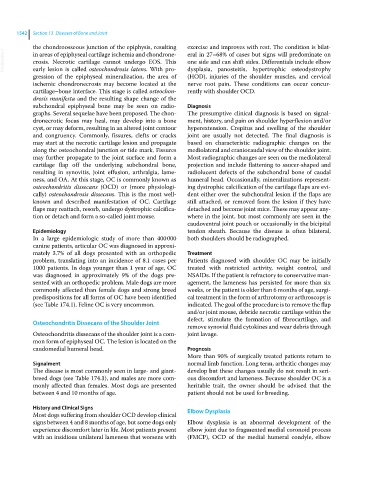Page 1604 - Clinical Small Animal Internal Medicine
P. 1604
1542 Section 13 Diseases of Bone and Joint
the chondroosseous junction of the epiphysis, resulting exercise and improves with rest. The condition is bilat-
VetBooks.ir in areas of epiphyseal cartilage ischemia and chondrone- eral in 27–68% of cases but signs will predominate on
one side and can shift sides. Differentials include elbow
crosis. Necrotic cartilage cannot undergo EOS. This
early lesion is called osteochondrosis latens. With pro-
(HOD), injuries of the shoulder muscles, and cervical
gression of the epiphyseal mineralization, the area of dysplasia, panosteitis, hypertrophic osteodystrophy
ischemic chondronecrosis may become located at the nerve root pain. These conditions can occur concur-
cartilage–bone interface. This stage is called osteochon- rently with shoulder OCD.
drosis manifesta and the resulting shape change of the
subchondral epiphyseal bone may be seen on radio- Diagnosis
graphs. Several sequelae have been proposed. The chon- The presumptive clinical diagnosis is based on signal-
dronecrotic focus may heal, may develop into a bone ment, history, and pain on shoulder hyperflexion and/or
cyst, or may deform, resulting in an altered joint contour hyperextension. Crepitus and swelling of the shoulder
and congruency. Commonly, fissures, clefts or cracks joint are usually not detected. The final diagnosis is
may start at the necrotic cartilage lesion and propagate based on characteristic radiographic changes on the
along the osteochondral junction or tide mark. Fissures mediolateral and craniocaudal view of the shoulder joint.
may further propagate to the joint surface and form a Most radiographic changes are seen on the mediolateral
cartilage flap off the underlying subchondral bone, projection and include flattening to saucer‐shaped and
resulting in synovitis, joint effusion, arthralgia, lame- radiolucent defects of the subchondral bone of caudal
ness, and OA. At this stage, OC is commonly known as humeral head. Occasionally, mineralizations represent-
osteochondritis dissecans (OCD) or (more physiologi- ing dystrophic calcification of the cartilage flaps are evi-
cally) osteochondrosis dissecans. This is the most well‐ dent either over the subchondral lesion if the flaps are
known and described manifestation of OC. Cartilage still attached, or removed from the lesion if they have
flaps may reattach, resorb, undergo dystrophic calcifica- detached and become joint mice. These may appear any-
tion or detach and form a so‐called joint mouse. where in the joint, but most commonly are seen in the
caudoventral joint pouch or occasionally in the bicipital
Epidemiology tendon sheath. Because the disease is often bilateral,
In a large epidemiologic study of more than 400 000 both shoulders should be radiographed.
canine patients, articular OC was diagnosed in approxi-
mately 3.7% of all dogs presented with an orthopedic Treatment
problem, translating into an incidence of 8.1 cases per Patients diagnosed with shoulder OC may be initially
1000 patients. In dogs younger than 1 year of age, OC treated with restricted activity, weight control, and
was diagnosed in approximately 9% of the dogs pre- NSAIDs. If the patient is refractory to conservative man-
sented with an orthopedic problem. Male dogs are more agement, the lameness has persisted for more than six
commonly affected than female dogs and strong breed weeks, or the patient is older than 6 months of age, surgi-
predispositions for all forms of OC have been identified cal treatment in the form of arthrotomy or arthroscopy is
(see Table 174.1). Feline OC is very uncommon. indicated. The goal of the procedure is to remove the flap
and/or joint mouse, debride necrotic cartilage within the
defect, stimulate the formation of fibrocartilage, and
Osteochondritis Dissecans of the Shoulder Joint
remove synovial fluid cytokines and wear debris through
Osteochondritis dissecans of the shoulder joint is a com- joint lavage.
mon form of epiphyseal OC. The lesion is located on the
caudomedial humeral head. Prognosis
More than 90% of surgically treated patients return to
Signalment normal limb function. Long term, arthritic changes may
The disease is most commonly seen in large‐ and giant‐ develop but these changes usually do not result in seri-
breed dogs (see Table 174.1), and males are more com- ous discomfort and lameness. Because shoulder OC is a
monly affected than females. Most dogs are presented heritable trait, the owner should be advised that the
between 4 and 10 months of age. patient should not be used for breeding.
History and Clinical Signs Elbow Dysplasia
Most dogs suffering from shoulder OCD develop clinical
signs between 4 and 8 months of age, but some dogs only Elbow dysplasia is an abnormal development of the
experience discomfort later in life. Most patients present elbow joint due to fragmented medial coronoid process
with an insidious unilateral lameness that worsens with (FMCP), OCD of the medial humeral condyle, elbow

